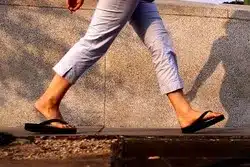How To Fix Plantar Fasciitis And Get Back To Pain-Free Runs And Workouts

It’s that time of year when winter has finally heaved its last frigid breath and exited the building.
We all look forward to springing ahead with warmer days, later sunsets, and walks through the park.
The change in seasons is also marked with a switch in outfits as we exchange heavy down coats for lightweight jackets and boots for flip-flops.
What Is Plantar Fasciitis?
It is often around this time at our New York physical therapy clinic, that we see a gradual increase of patients complaining about heel pain.
The onset is usually sudden with no traumatic injury, and patients are shocked that their first step out of bed in the morning is now painful.
The pain quickly resolves after a short walk or with stretching, but the next morning is often a repeat performance.
These are the classic signs of plantar fasciitis.
Painful walking in the morning and a point-specific tenderness around the heel.
High Heels, Flip Flops, Running Shoes, And Their Connection To Plantar Fasciitis
Theoretically, this change happens in women who often wear high heels and then suddenly switch to wearing a shoe with a very low heel or no heel at all, as with flip-flops.
The plantar fascia, a thick sheet of connective tissue on the underside of the foot, may get tight over time due to the positioning of the foot while in heels.
The abrupt change in footwear (coupled with walking on hard city sidewalks) puts a strain on the fascia and its connection to the heel, resulting in inflammation and pain.
How To Avoid Plantar Fasciitis Without Relying On Painkillers
It’s not realistic to ask patients to give up their collection of high-heeled shoes or to wear clunky orthotic shoes in the height of summer, but we can prepare for the change in footwear.
A simple stretch of the calves, which is comprised of two different muscles, can help to reduce tightness through the back of the lower leg.
Secondly, Towel Scrunches are a simple exercise for plantar fasciitis to strengthen the short muscles of the underside of the foot and may help to relieve some of the strain on the plantar fascia.
Sometimes, however, the pain may persist.
If you’ve tried stretching and exercises for your foot and heel pain, and can’t seem to treat your plantar fasciitis yourself, then it’s time to do something different.
Fast Relief From Plantar Fasciitis, Foot, Heel, And Ankle Pain
As an expert physical therapist, who’s worked with thousands of people overcome aches, pains, and injuries that stop them from working out, getting fitter and stronger, and struggling with daily pain, I can help you!
At our clinic, we get unbeatable relief from foot and ankle problems (such as plantar fasciitis) by evaluating the mechanics of your foot, ankle, and entire leg, and performing a gait analysis. Along with skilled manual therapy, strengthening exercises, and a simple but powerful home program, you should be well on your way to walking without pain fast!
This is very different from a normal visit to your doctor, where you are seen for 10 minutes, and rushed out of the door with a prescription for pills and the standard advice to “rest for two weeks”.
If you are experiencing these symptoms, it may be time to stop wishing it away – come in, and let’s get started!
Springtime should be enjoyed, with a (pain-free) spring in your step!
And right now, we are offering a limited number of Free Discovery Vist.
These “no-sweat” appointments are 30-minute, and on a 1-1 basis with an expert who wants to get you pain-free, and back to the gym, running, and waking up without that annoying foot pain FAST!
It’s 100% free too – but as there is such high demand at our New York clinic, we have to put a limit on the number of Free Discovery Visits available.
To arrange yours, simply call us on 646-430-5717 or click the link below.
